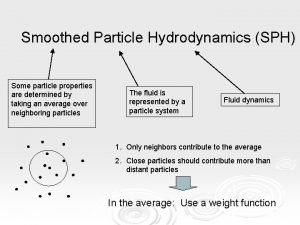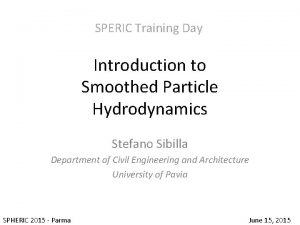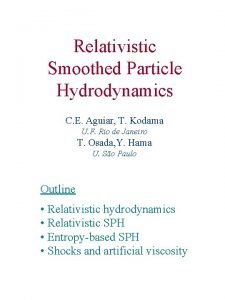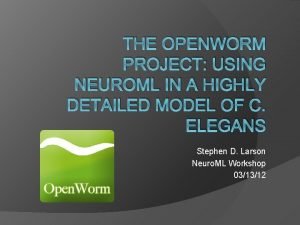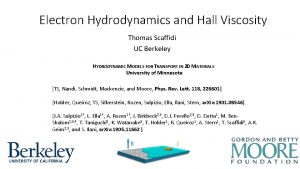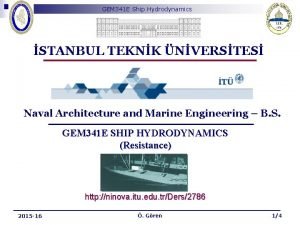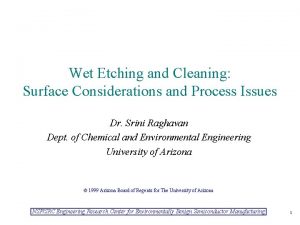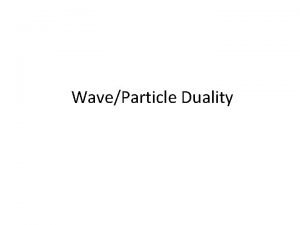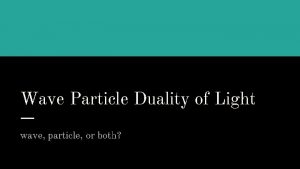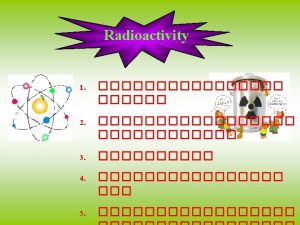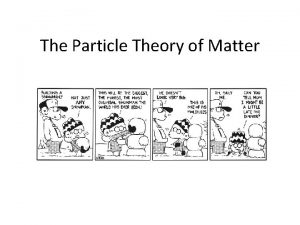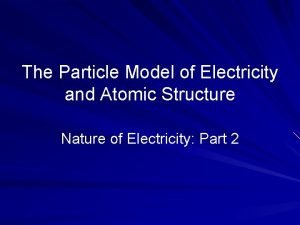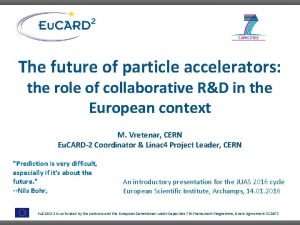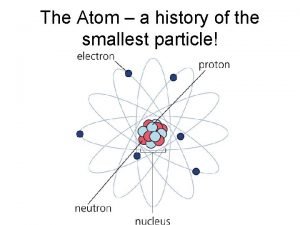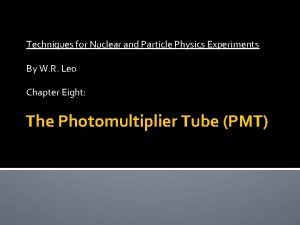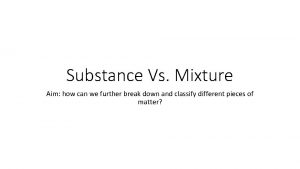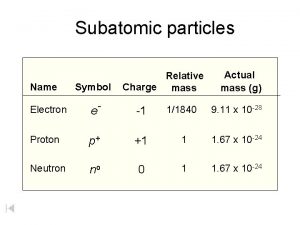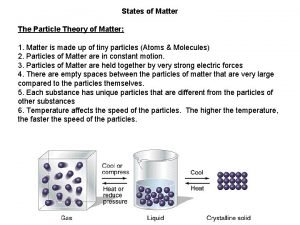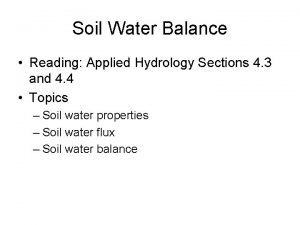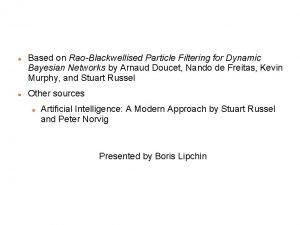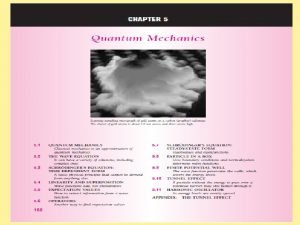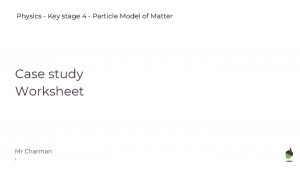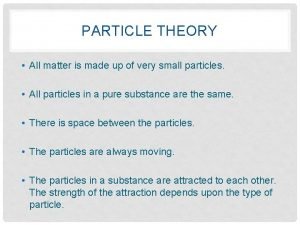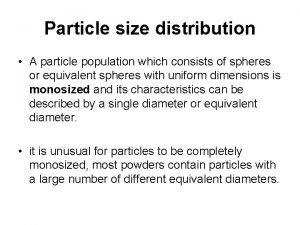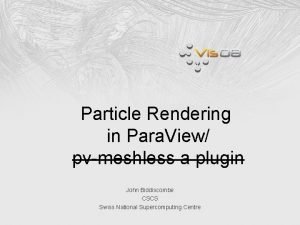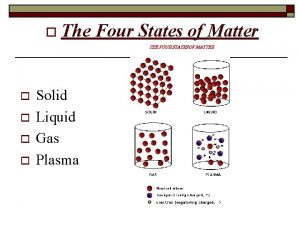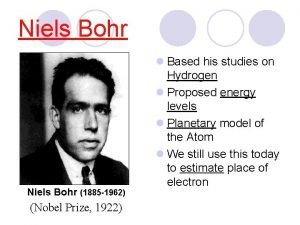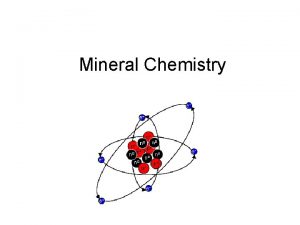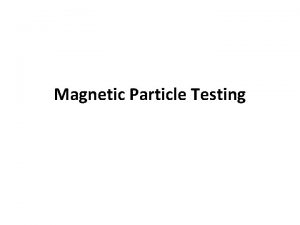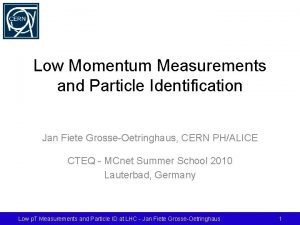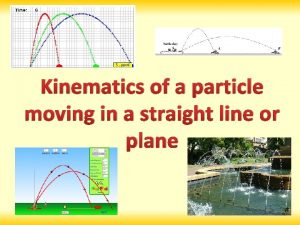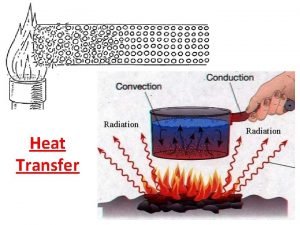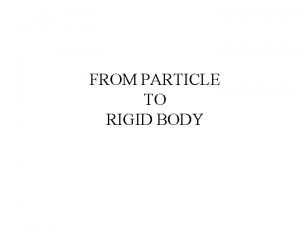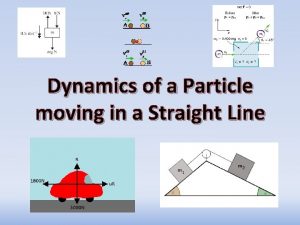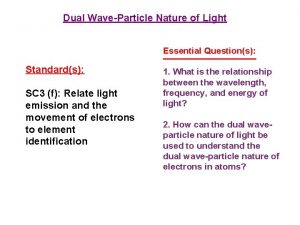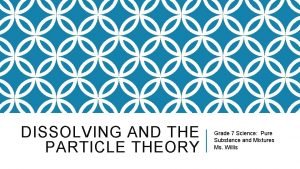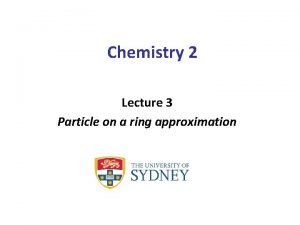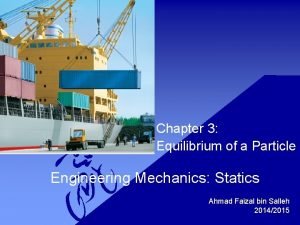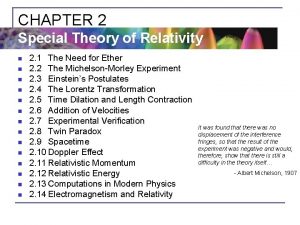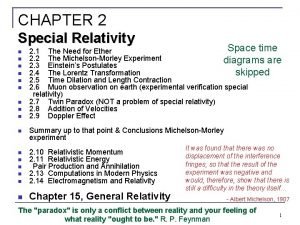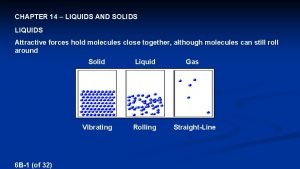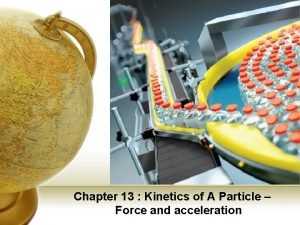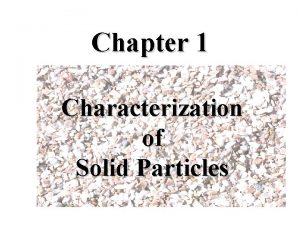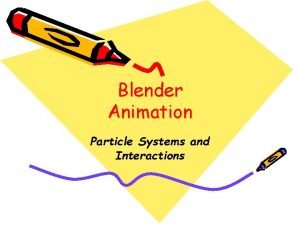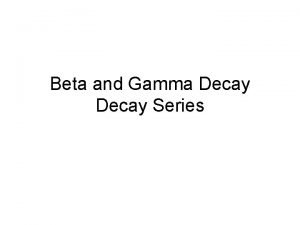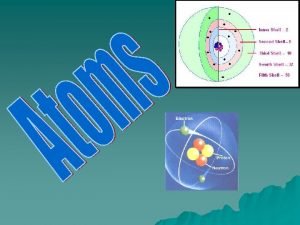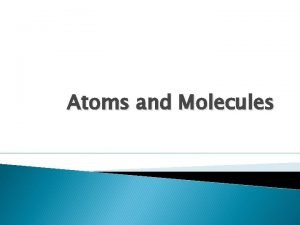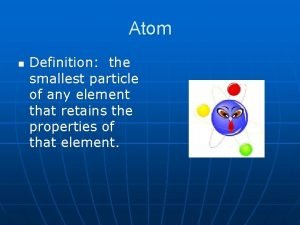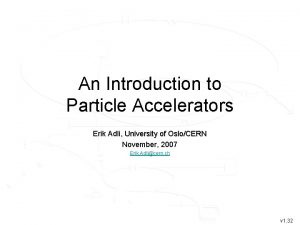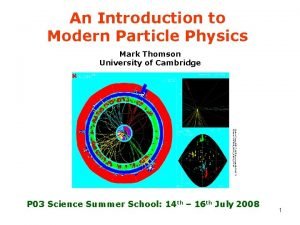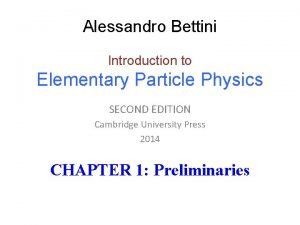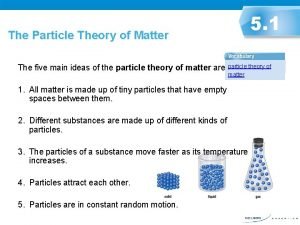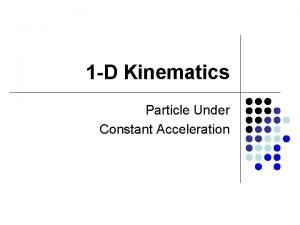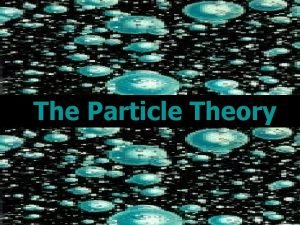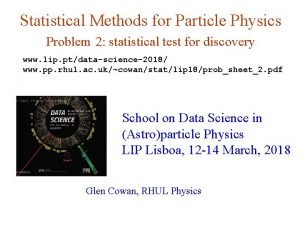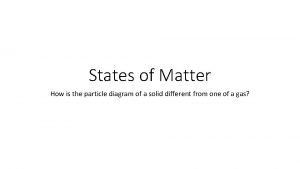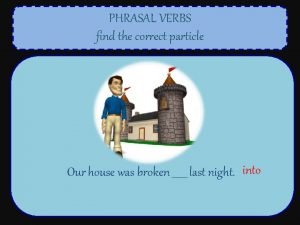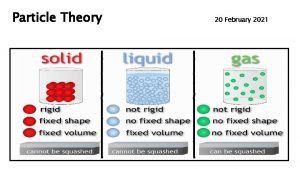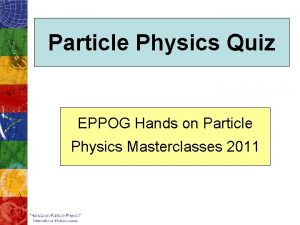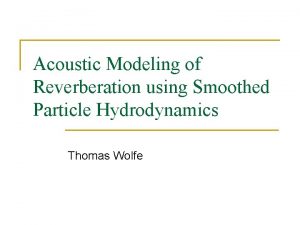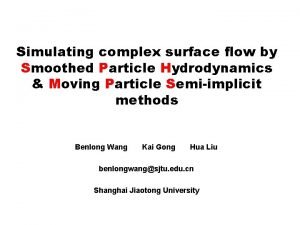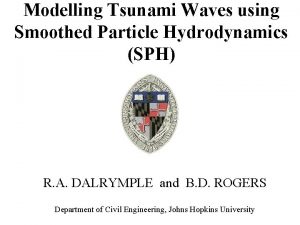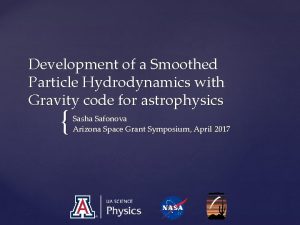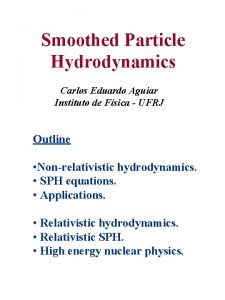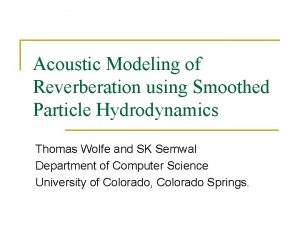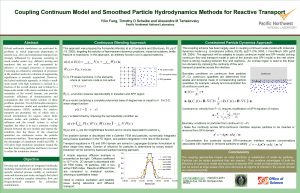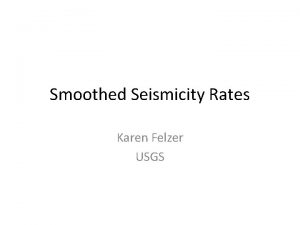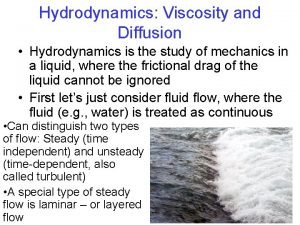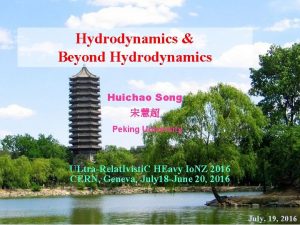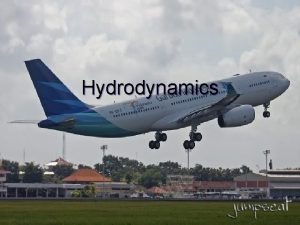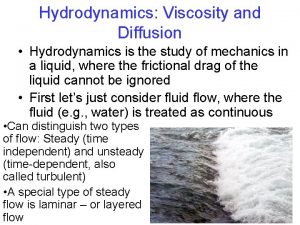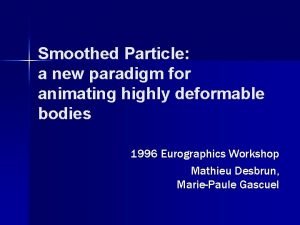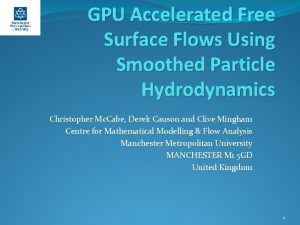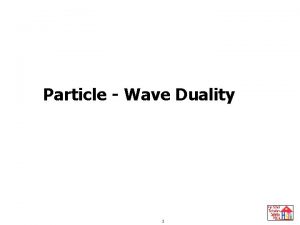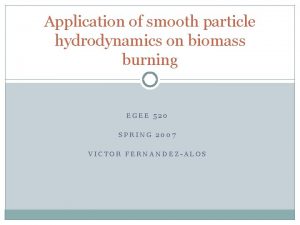SPERIC Training Day Introduction to Smoothed Particle Hydrodynamics




































































































- Slides: 100

SPERIC Training Day Introduction to Smoothed Particle Hydrodynamics Stefano Sibilla Department of Civil Engineering and Architecture University of Pavia SPHERIC 2015 - Parma June 15, 2015

Lesson schedule • • • Lagrangian methods in fluid mechanics • • • Navier-Stokes equations in Lagrangian form Kernel approximation of a function and its derivative Discretization: smoothed particle approximation Consistency issues in SPH: boundaries and particle disorder Renormalization of the kernel function and of its gradient Examples of kernel functions SPH formulation of the Navier-Stokes equations Weakly Compressible vs. Incompressible SPH Neighbour search algorithms Wall boundary treatment: ghost particles, barrier particles, integral conditions Inflow and outflow boundaries SPHERIC 2015 - Parma June 15, 2015

Continuum mechanics • Phenomena described by PDEs in space-time • Solution feasible only via numerical analysis • Numerical analysis requires: • Discretization of the geometry (e. g. space or mass) • Discretization of the governing PDEs • Solution algorithm suitable to PDEs character (e. g. for 2 nd order PDEs: hyperbolic, parabolic or elliptic) SPHERIC 2015 - Parma June 15, 2015

Lagrangian vs. Eulerian • Conservation of a mass-dependent property G can be written either: • by considering its time evolution for a given mass (or point mass): Lagrangian description • by considering its time evolution within a given (infinitesimal) volume fixed in space: Eulerian description • Numerical methods can be equivalently based on both descriptions SPHERIC 2015 - Parma June 15, 2015

Mesh-based vs. Meshless • Discretization of geometry (space volume or material mass) means approximate solution of the governing PDEs in a finite set of points (nodes) in space • These points can (not: need to) be connected by fixed topological links (mesh) • Approximate (i. e. numerical) solution needs necessarily: • proper interpolation of conserved properties far from the nodes • proper discretization of the differential operators in the PDEs SPHERIC 2015 - Parma June 15, 2015

Mesh-based example: FEM • Governing conservation PDE: • Interpolation • Discretization (W = Nj) SPHERIC 2015 - Parma June 15, 2015

Mesh-based vs. Meshless • Discretization of geometry (space volume or material mass) means approximate solution of the governing PDEs in a finite set of points (nodes) in space • Interpolation does not need to be based on a mesh (e. g. kernel interpolation, MLS) • Issues: particle distribution, boundaries SPHERIC 2015 - Parma June 15, 2015

Examples • Steady flow in a safety valve • Mesh-based, Eulerian, FVM • Refinement where high-gradients occur SPHERIC 2015 - Parma June 15, 2015

Examples • Steady flow in a safety valve • Mesh-based, Eulerian, FVM • Refinement where high-gradients occur SPHERIC 2015 - Parma June 15, 2015

Examples • Transient flow in a safety valve • Mesh-based, ALE, FVM • Moving boundaries, refinement not always possible at best SPHERIC 2015 - Parma June 15, 2015

Examples • Transient flow in a safety valve • Mesh-based, ALE, FVM • Moving boundaries, refinement not always possible at best SPHERIC 2015 - Parma June 15, 2015

Examples • Deformation of a buiding (church tower) • Mesh-based, Lagrangian, FEM • Small deformations, permanent link between elements SPHERIC 2015 - Parma June 15, 2015

Examples • Dam break flow • Meshless, Lagrangian, SPH • Large deformations, mixing, free fronts not known a priori SPHERIC 2015 - Parma June 15, 2015

Examples • Outflow from safety valve • Meshless, Lagrangian, SPH • Large deformations, mixing, free fronts not known a priori SPHERIC 2015 - Parma June 15, 2015

Examples • Outflow from safety valve • Meshless, Lagrangian, SPH • Large deformations, mixing, free fronts not known a priori t = 10 ms t = 20 ms t = 40 ms SPHERIC 2015 - Parma June 15, 2015

SPH basics: kernel approximation • If is a continuous function on V, the following identity holds: • Kernel approximation SPHERIC 2015 - Parma June 15, 2015

Kernel properties To approximate the Dirac d function, must have the following properties: • usually isotropic (even function) • defined on a compact support W : • tending to the Dirac d function: • normalized: h is defined as the smoothing length SPHERIC 2015 - Parma June 15, 2015

Kernel approximation of derivatives • If is continuous and differentiable on W: • the differential operator can be moved on the kernel (as in FEM with shape functions): SPHERIC 2015 - Parma June 15, 2015

Kernel approximation of derivatives • gradient of a scalar function: • 2 nd order derivatives • Laplacian of a function: …but it will be shown that consistency problems can arise. SPHERIC 2015 - Parma June 15, 2015

From continuum to particles • we study the dynamics of a continuum medium • we approximate the continuum media with elements (particles) of initial volume Vi • we associate a mass (and a density) to each particle i mi = r i V i i SPHERIC 2015 - Parma June 15, 2015

Particle approximation of a function the kernel approximation of the real function U(xi) : W can be written in discrete form: j where the summation is extended to all the particles j for which: ξh i SPHERIC 2015 - Parma June 15, 2015

Particle approximation of derivatives • By discretization of the kernel interpolation formulas we get: • SPH approximation of : ξh • SPH approximation of : i j • and so on… SPHERIC 2015 - Parma June 15, 2015

SPH consistency • Lax theorem of numerical analysis: convergence guaranteed by stability and consistency • kth order consistency: exact reproduction of a kth order polynomial function f(x) 0 th order: f(x) = a 1 st order: f(x) = a x + b 2 nd order: f(x) = a x 2 + b x + c • etc… kth order consistency guarantees (k+1)th order accuracy SPHERIC 2015 - Parma June 15, 2015

0 th order SPH consistency (1 D) f(x) = a • Consistency of the kernel approximation requires: • which implies: • 0 th order kernel consistency is guaranteed by the kernel normalization condition. But… • Particle approximation may not satisfy exactly the 0 th order consistency condition (near boundaries or for non-uniform particle distribution) SPHERIC 2015 - Parma June 15, 2015

1 st order SPH consistency (1 D) f(x) = a x + b • Consistency of the kernel approximation requires: • which, given that • multiplying the normalization condition by xi and subtracting: • consistency guaranteed if the kernel is an even function… • …but particle consistency is not guaranteed a priori , leads to: SPHERIC 2015 - Parma June 15, 2015

1 D kernel functions • Cubic B-spline kernel (Monaghan & Lattanzio, 1985): x = 2

1 D kernel functions • Quintic spline kernel (Morris, 1996): x = 3

1 D kernel functions • Anti-cluster kernel (Gallati & Braschi, 2002): x = 2

1 D kernel functions • Wendland C-4 kernel (Wendland, 1995): x = 2

Check of particle consistency Reproduction of constant, linear, quadratic function 1 D domain, length 10 h; kernel support SPHERIC 2015 - Parma June 15, 2015

Check of particle consistency Cubic B-spline kernel with uniform particle distribution • Effect of boundaries (truncation of kernel function) • Effect of 1 st order consistency on computed parabolic function SPHERIC 2015 - Parma June 15, 2015

Effect of kernel function Cubic B-spline Quintic spline Cubic anticluster Uniformly spaced particle distribution • No appreciable effect of different kernel functions • All kernels used in a scheme which has 1 st order consistency for kernel approximation SPHERIC 2015 - Parma June 15, 2015

Effect of particle distribution (1) Uniform Irregular (random) • Random distribution is a realistic representation of particle disorder • Reason of strong errors: numerical approximation of integrals with the trapezoidal rule. SPHERIC 2015 - Parma June 15, 2015

Effect of particle distribution (2) Uniform Irregular (random) • Here the particle volume is computed exactly as the particle spacing Δx • Seems rather good… • Effect only on parabolic function reconstruction (owing to 1 st order consistency) SPHERIC 2015 - Parma June 15, 2015

Consistency of the first derivative f(x) = a f’(x) = 0 • Consistency of kernel approximation of gradient requires: • which implies: • 0 th order kernel consistency is guaranteed if the kernel is an even function (the gradient is an odd function). But… …particle approximation may not satisfy exactly the 0 th order consistency condition (near boundaries or for non-uniform particle distribution) SPHERIC 2015 - Parma June 15, 2015

Check of particle consistency Reproduction of the gradient of the constant, linear, quadratic function 1 D domain, length 10 h; kernel support: SPHERIC 2015 - Parma June 15, 2015

Effect of kernel function Cubic B-spline Quintic spline Cubic anticluster Uniformly spaced particle distribution • Derivative computed exactly for inner particles • Boundary effect can lead to errors in gradient reconstruction • No appreciable effect of different kernel functions SPHERIC 2015 - Parma June 15, 2015

Effect of particle distribution Uniform Irregular (random) • Results obtained with random distribution seem to be acceptable, however… SPHERIC 2015 - Parma June 15, 2015

Effect of particle distribution • If we reduce the particle number, the quality of results from the random distribution decreases strongly • Remember that and include first derivatives! SPHERIC 2015 - Parma June 15, 2015

Consistency of the second derivative f(x) = a or f(x) = a x + b f’’(x) = 0 • Consistency of kernel approximation of derivatives requires: • which implies: • 0 th order consistency is again guaranteed if the kernel is an even function, because its second derivative is also an even function • However, consistency of the particle approximation is not guaranteed and sensitivity to particle disorder is high • Accuracy of second derivatives can be poorer than that of first derivatives even for uniform particle distributions SPHERIC 2015 - Parma June 15, 2015

Effect of particle distribution • Strong effect of particle non-uniformity • Results obtained with the random distribution show non-negligible fluctuations in the second derivative. • Remember that viscous terms include second derivatives! SPHERIC 2015 - Parma June 15, 2015

Improved SPH consistency The function U can be expanded in Taylor series around xi: Multiplying by the kernel W and integrating over Ω we have: W even function SPHERIC 2015 - Parma June 15, 2015

Improved SPH consistency • Normalized kernel approximation: which restores 0 th order kernel consistency at the boundaries • Normalized particle approximation: (Shepard filtering) which restores 0 th order particle consistency also for non-uniform particle distributions

Effect of renormalization Cubic B-spline kernel Uniform particle distribution Random particle distribution with constant particle volume • 1 st order consistency restored • Effect of boundary deficiency strongly reduced • Effect of particle disorder strongly reduced

Improved consistency of 1 st derivative The kernel approximation of the Taylor expansion of U around xi can be multiplied by the x derivative of the kernel function, yielding: Truncated to 1 st order U(xi) known ∂U/ ∂x|xi unknown SPHERIC 2015 - Parma June 15, 2015

Improved consistency of 1 st derivative • Normalized 1 st derivative kernel approximation: which restores 1 st order kernel consistency at the boundaries • Normalized particle approximation: (Chen & Beraun, 2000) which restores 1 st order particle consistency also for non-uniform particle distributions

Effect of 1 st derivative renormalization Cubic B-spline kernel Uniform particle distribution Random particle distribution with constant particle volume • 1 st order consistency restored • Effect of boundary deficiency strongly reduced • Effect of particle disorder strongly reduced

Improved consistency of the gradient The function U can be expanded in Taylor series around xi: shifting to SPH interpolation with a convenient test function T and truncating to 1 st order, leads to: Which, using alternatively as T the kernel gradient components, yields the system: in the components of the gradient of U

Corrected kernel gradient • Alternative: use directly a corrected kernel gradient • Demonstration similar to the previous one (Bonet & Lok, 1999) SPHERIC 2015 - Parma June 15, 2015

Improved consistency of 2 nd derivative From the kernel approximation of the Taylor expansion of U around xi: Truncated to 2 nd order U(xi) and ∂U/ ∂x|xi known SPHERIC 2015 - Parma June 15, 2015

Improved consistency of 2 nd derivative one obtains: which restores 0 th order kernel consistency near the boundaries (the term only near boundaries) SPHERIC 2015 - Parma June 15, 2015

Improved consistency of 2 nd derivative The normalized particle approximation of the 2 nd derivative: where is the normalized first derivative already computed and 0 th order consistency is restored for a non-uniform particle distribution (Chen & Beraun, 2000) SPHERIC 2015 - Parma June 15, 2015

Effect of 2 nd derivative renormalization Cubic B-spline kernel Uniform particle distribution Random particle distribution with constant particle volume • 1 st order consistency restored • Effect of boundary deficiency strongly reduced • Effect of particle disorder strongly reduced

Alternative approach to restore consistency • Expand the function in Taylor series: • then derive the expansion, apply the particle approximation and solve simultaneously for the function and its gradient: (Liu & Liu, 2006) SPHERIC 2015 - Parma June 15, 2015

Alternative approach to restore consistency • the approach can be extended to higher-order derivatives (3 rd order consistency on the function, 2 nd order consistency on the first derivative) • it can become time-consuming when applied to 2 D and 3 D problems SPHERIC 2015 - Parma June 15, 2015

Effect of the alternative approach • Consistency restored up to the desired order • Polynomial functions up to 3 rd order exactly reproduced with their derivatives SPHERIC 2015 - Parma June 15, 2015

Navier-Stokes equations • Mass and momentum (and energy) conservation • Hydraulics: incompressible liquid, energy equation decoupled • SPH needs equations in Lagrangian form: SPHERIC 2015 - Parma June 15, 2015

Navier-Stokes equations • Explicit solution easier to handle (to manage particle displacement) • Two alternatives: • Projection methods (ISPH) • Artificial compressibility (WCSPH) • For artificial compressibility: Navier-Stokes equations for a Weakly Compressible fluid Small perturbations constant SPHERIC 2015 - Parma June 15, 2015

Navier-Stokes equations • Explicit solution easier to handle (to manage particle displacement) • Two alternatives: • Projection methods (ISPH) • Artificial compressibility (WCSPH) • For artificial compressibility: Navier-Stokes equations for a Weakly Compressible fluid Tait equation SPHERIC 2015 - Parma June 15, 2015

Continuity equation 3 alternatives have been devised to impose continuity : • compute the material derivative of density through an artificial compressibility model and obtain pressure through an equation of state for a weakly compressible liquid (WCSPH): • impose at each time step the SPH interpolation constraint on density (and, again, use an equation of state to obtain pressure) (WCSPH): • use projection methods and solve a Poisson equation for pressure (ISPH) SPHERIC 2015 - Parma June 15, 2015

Continuity equation • the continuity equation for compressible and weakly compressible flow (WCSPH) • becomes, in “plain” SPH form 2 h i j • however, in this form the divergence is not strictly zero for a constant field (at least, if no kernel gradient correction is performed) SPHERIC 2015 - Parma June 15, 2015

Continuity equation • the continuity equation can be suitably modified • being: • the following SPH approximation can be obtained: • which is also consistent with kernel gradient renormalization formulas SPHERIC 2015 - Parma June 15, 2015

Momentum equation • in the momentum equation • the pressure term becomes: • in this form, the action-reaction principle is not guaranteed (the force of i on j is not equal to the force of j on i) SPHERIC 2015 - Parma June 15, 2015

Momentum equation • the pressure term in the momentum equation can be suitably modified • being • the following SPH approximation can be obtained • which, however, conflicts with kernel gradient renormalization formulas… SPHERIC 2015 - Parma June 15, 2015

Viscous stress • the viscous stress term can be computed in its incompressible form • viscous stress can be computed by applying the second derivative directly to the kernel function • however, the “plain” approximation is not used in practice as we have seen that it can be too sensitive to particle disorder • for constant viscosity, we can also use renormalized second derivatives SPHERIC 2015 - Parma June 15, 2015

Viscous stress • alternatively, viscous stress can be computed by direct estimation of the velocity gradient • and, being: • the following SPH approximation can be obtained • which can be directly applied also to non-Newtonian fluids and/or turbulent flows SPHERIC 2015 - Parma June 15, 2015

Viscous stress • alternatively, expanding the velocity around point xi: • rearranging: • the following SPH approximation can be obtained • used also to build artificial viscosity terms (Monaghan) SPHERIC 2015 - Parma June 15, 2015

Artificial viscosity • developed by Monaghan to avoid instabilities in shock waves and to prevent interpenetration of particles • it is introduced only when i j • the artificial kinematic viscosity coefficient is proportional to • the term to be added to the Navier-Stokes equations is: • a is known as Monaghan’s viscosity coefficient SPHERIC 2015 - Parma June 15, 2015

WCSPH • artificial compressibility (WCSPH = Weakly Compressible SPH) easy to code • Ma < 0. 1 condition always respected to guarantee “almost incompressible” behavior • However: - pressure fluctuations arise - pressure becomes both physical variable and a numerical parameter - liquid can sometimes show unexpected compressibility effects SPHERIC 2015 - Parma June 15, 2015

Vertical oscillating jet (Espa et al. , 2008) Re = 12000, stable Re = 16000 V = 0. 78 m/s ^ e = 106 Pa c = 31. 6 m/s Ma = 0. 025 Re = 21000 V = 1 m/s ^ e = 106 Pa c = 31. 6 m/s Ma = 0. 032 SPHERIC 2015 - Parma June 15, 2015

Vertical oscillating jet (Espa et al. , 2008) Re = 12000, stable Re = 16000 V = 0. 78 m/s ^ e = 5· 104 Pa c = 7. 1 m/s Ma = 0. 11 Re = 21000 V = 1 m/s ^ e = 106 Pa c = 31. 6 m/s Ma = 0. 032 SPHERIC 2015 - Parma June 15, 2015

Jet impinging on a surface (Molteni & Colagrossi, 2008) Inviscid fluid (Euler equations), WCSPH Strong pressure fluctuations: • depend on resolution pressure at stagnation point SPHERIC 2015 - Parma June 15, 2015

Jet impinging on a surface (Molteni & Colagrossi, 2008) Inviscid fluid (Euler equations), WCSPH Strong pressure fluctuations: • depend on resolution • Spoil the accuracy/reliability of the pressure field SPHERIC 2015 - Parma June 15, 2015

WCSPH correction techniques • pressure (or density) smoothing • Density diffusion term in the continuity equation (d-SPH): SPHERIC 2015 - Parma June 15, 2015

ISPH • an alternative to artificial compressibility is the SPH form of a projection method • classical projection method by Chorin, applied to SPH: SPHERIC 2015 - Parma June 15, 2015

ISPH • in the SPH formalism: • linear system with sparse coefficient matrix • proper boundary conditions • corrected values for velocity and position: SPHERIC 2015 - Parma June 15, 2015

Cavity flow (Le Touze, Quinlan, Colagrossi et al. , 2012) SPHERIC 2015 - Parma June 15, 2015

Neighbour search • needed at each time step to determine links between particles • several strategies: e. g. linked list 1) determine the limits of space occupied by particles Vajont landslide (Manenti et al. , 2014) SPHERIC 2015 - Parma June 15, 2015

Neighbour search • needed at each time step to determine links between particles • several strategies: e. g. linked list 2) superimpose a Cartesian mesh with 2 h spacing and order particles on i, j cells j i SPHERIC 2015 - Parma June 15, 2015

Neighbour search • needed at each time step to determine links between particles • several strategies: e. g. linked list 3) determine the cell ip , jp to which particle p belongs j i SPHERIC 2015 - Parma June 15, 2015

Neighbour search • needed at each time step to determine links between particles • several strategies: e. g. linked list 4) Compute particle distances from p only in the cells with ip-1 < ip+1 and jp-1 < jp+1 j i SPHERIC 2015 - Parma June 15, 2015

Time integration • various approaches have been developed for the integration of the ODEs in time which result from SPH discretization • explicit: • semi-implicit: Courant condition SPHERIC 2015 - Parma June 15, 2015

Time integration • predictor-corrector (Monaghan’s reversible scheme): • Runge-Kutta methods • … SPHERIC 2015 - Parma June 15, 2015

XSPH • • Explicit solution of momentum equation Velocity correction • • Corrected values used in particle motion Uncorrected values used in continuity equation and for stress evaluation SPHERIC 2015 - Parma June 15, 2015

Boundary conditions • Assigned conditions need to be enforced at boundaries to ensure correct physical conditions to the required flow: • wall boundary conditions to velocity and density (pressure) • inflow and outflow conditions according to physics • free surface conditions (only to pressure in ISPH) • Interface conditions (for multiphase flow or fluid-structure interaction) • Further numerical reasons: • to guarantee full coverage of kernel support at boundaries (if no accurate kernel gradient correction is employed) • to prevent wall boundaries from particle penetration (not excluded a priori with explicit methods) SPHERIC 2015 - Parma June 15, 2015

Ghost particles (Randles & Libersky , 1996) • particle position is mirrored from the flow to an external fictitious layer • velocity: slip condition 2 h or no slip condition • pressure/density/stress tensor: Neumann condition i g j • solution of momentum and continuity equations includes boundary particles SPHERIC 2015 - Parma June 15, 2015

Ghost particles • Advantages: • easy to code for plane boundaries • rather computationally efficient 2 h i g j • prevents efficiently particle penetration • restores consistency at boundaries • Drawbacks: • curved boundaries generate coarser/finer particle distribution • corners generate duplication of ghost particles ? g 2 h i g’ j SPHERIC 2015 - Parma June 15, 2015

Ghost particles • Improvement: • local planar approximation of the boundary • ghost particle extrapolation in the “empty” kernel support of each inner particle • make use of virtual particles to define boundary and locate ghost particles (VBM) 2 h g i j • more computationally expensive • can restore consistency at boundaries to the desired order SPHERIC 2015 - Parma June 15, 2015

Fixed boundary particles • fixed “ghost” particles • values in particle b based on SPH interpolation in mirror point p 2 h b p • fixes some “geometrical” drawbacks of ghost particle method j SPHERIC 2015 - Parma June 15, 2015

Fixed boundary particles • barrier particles • located directly on the boundary • apply a normal repulsive force on the inner particles 2 h • analogous to Lennard-Jones potential in molecular interaction • not completely physically-based j SPHERIC 2015 - Parma June 15, 2015

Boundary integrals • the particle approximation can be split in a flow (F) and boundary (B) contribution • the term related to the boundary can be computed analytically from the kernel / kernel gradient function b 2 h B F i a j • e. g. continuity equation: SPHERIC 2015 - Parma June 15, 2015

Inflow condition • Extra layer of particles 2 h wide • Assigned inflow conditions, constant within layer • Particles moving with prescribed velocity in the layer 2 h Imposed Computed SPHERIC 2015 - Parma June 15, 2015

Inflow condition • Extra layer of particles 2 h wide • Assigned inflow conditions, constant within layer • Particles moving with prescribed velocity in the layer 2 h Imposed Computed SPHERIC 2015 - Parma June 15, 2015

Outflow condition • Extra layer of particles 2 h wide • Assigned outflow conditions, constant within layer • Particles velocity not updated any more in the layer Computed SPHERIC 2015 - Parma June 15, 2015

Outflow condition • Extra layer of particles 2 h wide • Assigned outflow conditions, constant within layer • Particles velocity not updated any more in the layer Computed “Frozen” or prescribed SPHERIC 2015 - Parma June 15, 2015

Outflow condition • Extra layer of particles 2 h wide • Assigned outflow conditions, constant within layer • Particles velocity not updated any more in the layer 2 h Computed “Frozen” removed or prescribed SPHERIC 2015 - Parma June 15, 2015

Riemann invariants for open b. c. • boundary values can be assigned directly or, more physically, according to wave propagation in the weakly compressible flow • simplified case: • 2 D Euler equations • open boundaries normal to x being: g = 7 SPHERIC 2015 - Parma June 15, 2015

Riemann invariants for open b. c. • the information crossing the open boundary normal to x reduces to: • and can be written in characteristic form: where R I s the vector of Riemann invariants SPHERIC 2015 - Parma June 15, 2015

Riemann invariants for open b. c. • the inlet boundary condition will require two prescribed values for the Riemann invariants, while third will be extrapolated from inside the fluid domain: b F 2 h i SPHERIC 2015 - Parma June 15, 2015

Riemann invariants for open b. c. • the outlet boundary condition will require one prescribed value for the Riemann invariants, while the other two will be extrapolated from inside the fluid domain: F b 2 h i SPHERIC 2015 - Parma June 15, 2015
 Smoothed particle hydrodynamics
Smoothed particle hydrodynamics Speric shock
Speric shock Speric shock
Speric shock Day 1 day 2 day 3 day 4
Day 1 day 2 day 3 day 4 Sharks body shape
Sharks body shape Hydrodynamics
Hydrodynamics Frother hydrodynamics
Frother hydrodynamics Thomas scaffidi
Thomas scaffidi Hydrodynamics
Hydrodynamics Gem
Gem Day 1 day 2 day 817
Day 1 day 2 day 817 Schoolmax gradebook
Schoolmax gradebook Ocean the part day after day
Ocean the part day after day Day to day maintenance
Day to day maintenance Physical science chapter 6 review answers
Physical science chapter 6 review answers I don't know about tomorrow
I don't know about tomorrow Romeo and juliet sunday
Romeo and juliet sunday Growing day by day
Growing day by day Seed germination inhibitors examples
Seed germination inhibitors examples Conclusion of seed germination
Conclusion of seed germination Seeds vs spores
Seeds vs spores I live for jesus day after day
I live for jesus day after day One day in heaven
One day in heaven Day one day one noodle ss2
Day one day one noodle ss2 Day one day one noodles ss2
Day one day one noodles ss2 Training is expensive without training it is more expensive
Training is expensive without training it is more expensive Perbedaan on the job training dan off the job training
Perbedaan on the job training dan off the job training Aggression replacement training facilitator training
Aggression replacement training facilitator training Introduction of participants in training
Introduction of participants in training Introduction to employee training and development
Introduction to employee training and development Solid to heat
Solid to heat Wet etch clean filters
Wet etch clean filters Wave particle duality questions
Wave particle duality questions Wave-particle duality
Wave-particle duality Packing arrangement of powder slideshare
Packing arrangement of powder slideshare Whats a beta particle
Whats a beta particle Tightly packed in a disorderly manner
Tightly packed in a disorderly manner Particle model of electricity
Particle model of electricity The long-term future of particle accelerators
The long-term future of particle accelerators Smallest known particle
Smallest known particle Pmt particle physics
Pmt particle physics Mixture particle diagram
Mixture particle diagram Symbols for subatomic particles
Symbols for subatomic particles What is the particle theory of matter
What is the particle theory of matter Properties of a solid
Properties of a solid Soil particle size classification
Soil particle size classification Negatron emission
Negatron emission Rao blackwell particle filter
Rao blackwell particle filter Well behaved wave function
Well behaved wave function Particle model of matter exam questions
Particle model of matter exam questions Physcial change
Physcial change Particle theory of matter
Particle theory of matter Coulter counter method
Coulter counter method Para view
Para view Bayes filter matlab
Bayes filter matlab Plasma particles arrangement
Plasma particles arrangement Niels bohr analogy
Niels bohr analogy Smallest particle of an element
Smallest particle of an element Circular magnetism
Circular magnetism Magnetic force particle
Magnetic force particle Particle identification
Particle identification Kinematics of a particle moving in a straight line answers
Kinematics of a particle moving in a straight line answers What is a particle
What is a particle Radiation
Radiation Particle vs rigid body
Particle vs rigid body Tachyonized materials
Tachyonized materials Light is a particle evidence
Light is a particle evidence Dynamics of a particle moving in a straight line
Dynamics of a particle moving in a straight line Photon
Photon Salt vs sugar dissolving in water
Salt vs sugar dissolving in water Dissolving and the particle theory
Dissolving and the particle theory Particle on a ring
Particle on a ring Particle equilibrium in 2d and 3d engineering mechanics
Particle equilibrium in 2d and 3d engineering mechanics Relativistic kinetic energy
Relativistic kinetic energy Rest energy of a proton
Rest energy of a proton Steel interstitial alloy
Steel interstitial alloy Kinetics of a particle force and acceleration
Kinetics of a particle force and acceleration Kinetic particle model
Kinetic particle model Characterization of solid particles
Characterization of solid particles Blender hair collision
Blender hair collision Symbol for beta particle
Symbol for beta particle Smallest particle on earth
Smallest particle on earth Smallest particle
Smallest particle Atoms are small hard particles
Atoms are small hard particles Proton
Proton Mark thomson particle physics
Mark thomson particle physics Particle classification diagram
Particle classification diagram 5 particle theory of matter
5 particle theory of matter Particle under constant acceleration
Particle under constant acceleration Non cellular particle
Non cellular particle Energy of particle in a box
Energy of particle in a box Particle theory examples
Particle theory examples Particle wordle
Particle wordle Particle physics
Particle physics State of matter particle diagram
State of matter particle diagram Particle bombardment
Particle bombardment Choose the correct particle.
Choose the correct particle. Particle therapy masterclass
Particle therapy masterclass Www.youtube.com
Www.youtube.com Every particle
Every particle Particle physics practice quiz
Particle physics practice quiz
